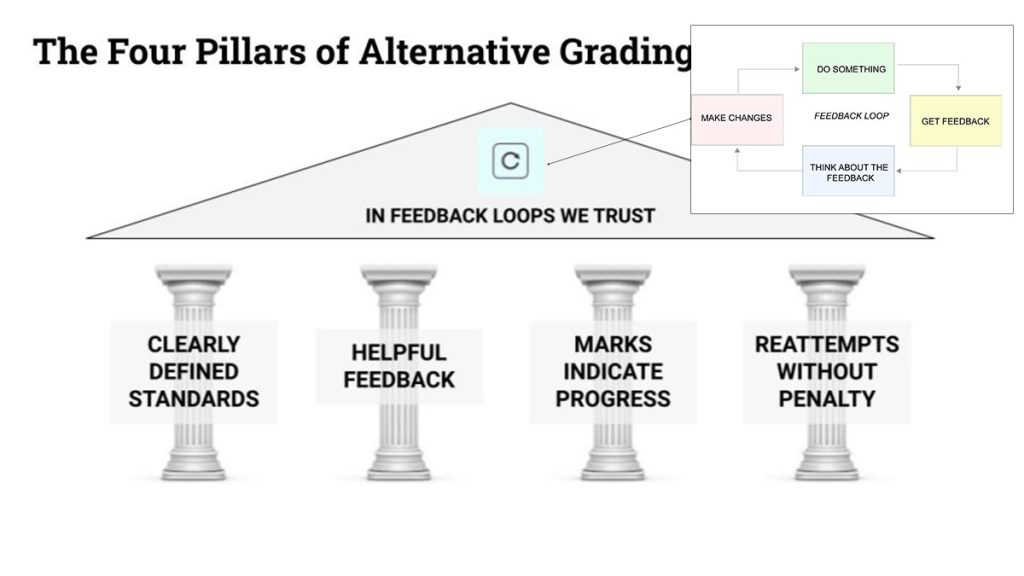Grading for Growth: Toward more humane, authentic, and trustworthy ways to evaluate student work
On Tuesday, March 18th, we hosted Dr. Robert Talbert, Professor of Mathematics and Senior Faculty Fellow for Learning Futures at Grand Valley State University to discuss the issues associated with traditional grading systems and explore “alternative” grading practices that align more accurately with how students learn.
Finding a New Religion
Dr. Talbert began his talk with his personal story about how his views of grades and grading evolved. Dr. Talbert admitted that when he was in school, he was very much motivated by grades and worked hard to achieve an “A.” However, when he began teaching as a graduate student at Vanderbilt University, he became increasingly frustrated with the transactional nature of grades–students were looking for a particular grade and not necessarily interested in the actual learning. He also noticed many false positives, e.g., some students who did well on tests but couldn’t demonstrate understanding in other contexts, and false negatives, e.g., students who did poorly on tests but otherwise seemed to understand the material during class discussion or in conversations during office hours, etc.
These and similar experiences during his early teaching career motivated Dr. Talbert to investigate why the A-F system of traditional grading emerged and became the standard that it is today. What he learned surprised him: grades as we know them didn’t appear until the late 1800s, originating at Mt. Holyoke College in 1884. He noted that the first university was established in 1088, making the current system relatively new, about “18% of the entire lifespan of higher education.” The reason this system was developed had nothing to do with the measurement of learning; it was designed by administrators to address administrative problems like how to transfer students between levels or schools between geographical areas.
The Flaws in the System
Dr. Talbert explained that many issues with traditional grading result in a flawed system, but he presented two that he considers the most serious, and they both have to do with statistics:
- Grades have construct validity issues. That is, grades do not effectively measure learning. For example, consider a grade of 50%: Does this number indicate that a student understands the concepts of the entire course at a 50% level, or does it mean they only understand 50% of the concepts in the course?
- Grades are categorical numbers. As such, mathematical manipulations of them are questionable, at best. [See: Traditional grades are (still) not mathematically valid, David Clark, Grading for Growth]
Grading for Growth
So, what are alternative strategies that accurately measure learning and also help students learn? Dr. Talbert highlighted the following four grading practices (there are others) that may be better measures of student learning (note: you can find more details about these approaches on Dr. Talbert’s Grading for Growth resource page).
- Standards-based grading
- Specifications grading
- Ungrading /collaborative grading
- Contract grading
These alternative grading approaches share four core pillars: clearly defined standards, helpful feedback, marks that indicate progress, and re-attempts without penalty. Taken together, these pillars create a continuous feedback loop that enables students to self-regulate their learning through reflection and revision until they achieve success. [See, Finding common ground with grading systems, Robert Talbert, Grading for Growth.]
Four Pillars of Alternative Grading
- Clearly Defined Standards that outline what students need to know and how to demonstrate what they know.
- Helpful Feedback that is brief, specific, descriptive, encouraging, targeted and timely and connects students’ work back to the clearly defined standards.
- Marks Indicate Progress that the student has made, indicating what they did well and what needs improvement. (Note that alternate grading approaches do not always include “marks,” ex. ungrading.)
- Re-attempts Without Penalty are allowed on assignments and/or certain types of assessments.

Dr. Talbert gave a brief overview of how he currently grades in his discrete mathematics course and provided links to the course documents and a video that takes a deep dive into the alternative grading design used in the course. He concluded the talk with advice for faculty and instructors who are thinking about adopting alternative grading schemes: “Keep it really simple and start small…pick one pillar and do one thing aligned with that pillar” that can grow over time into larger changes.

